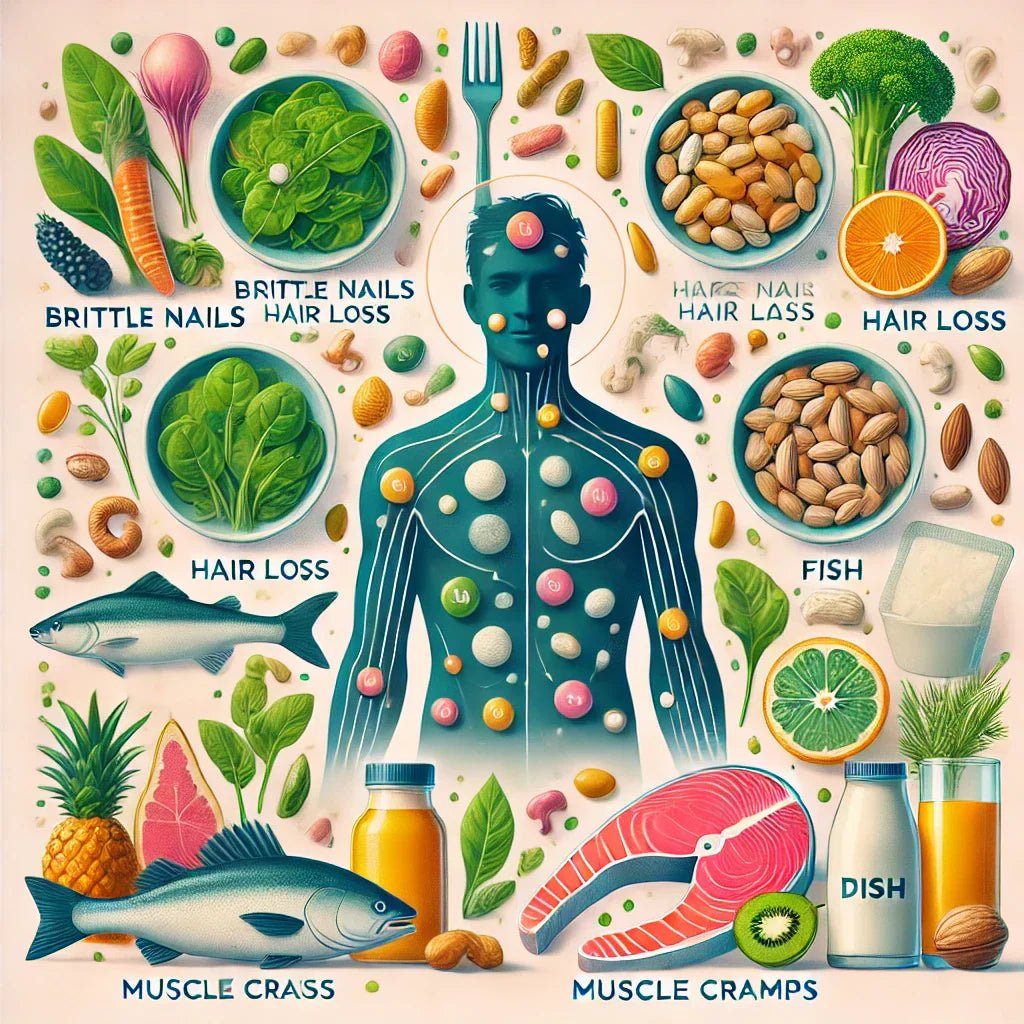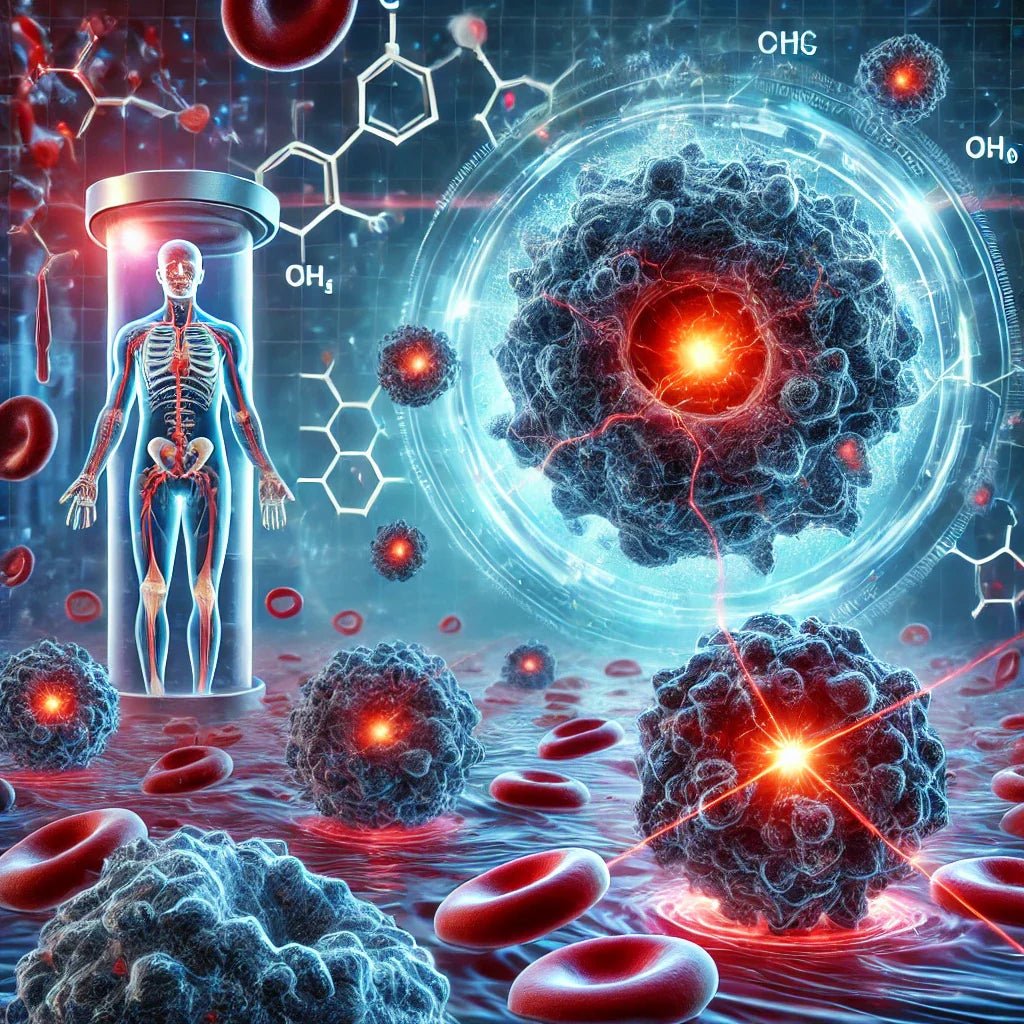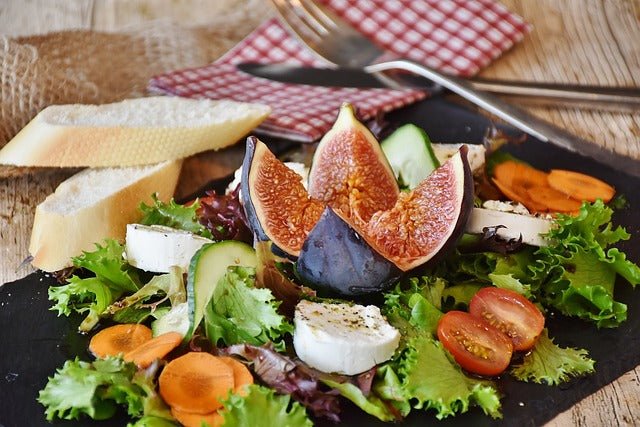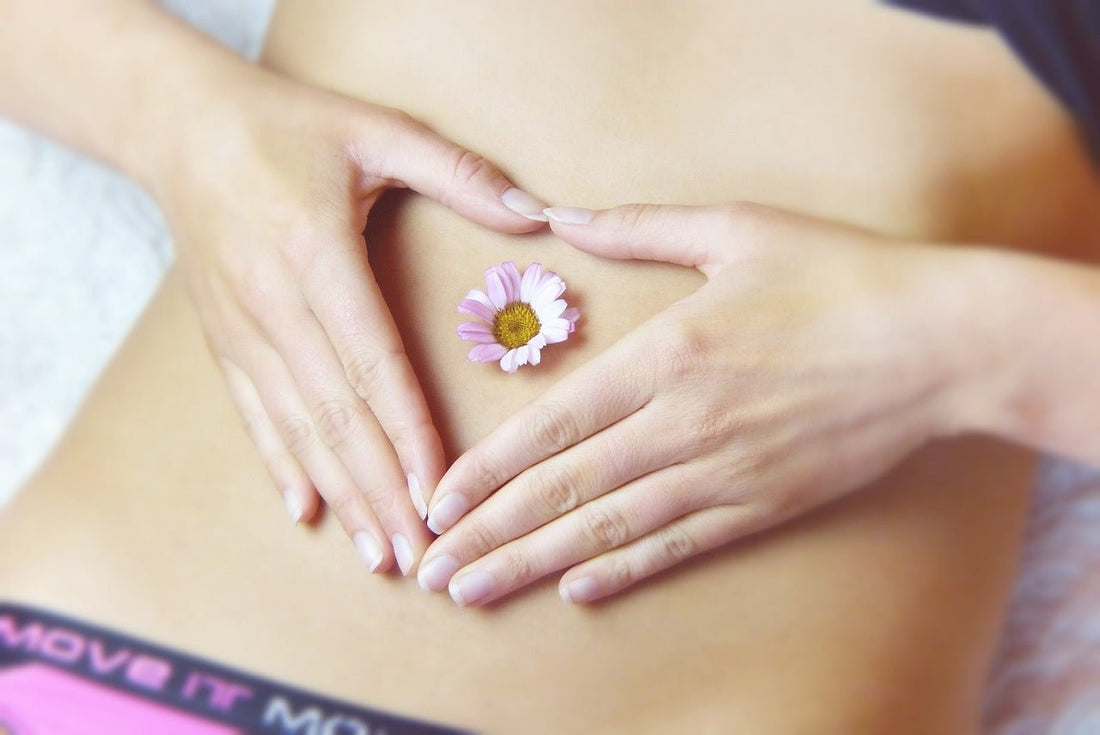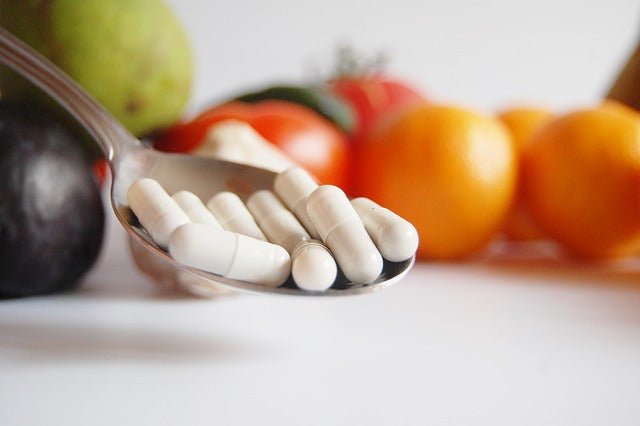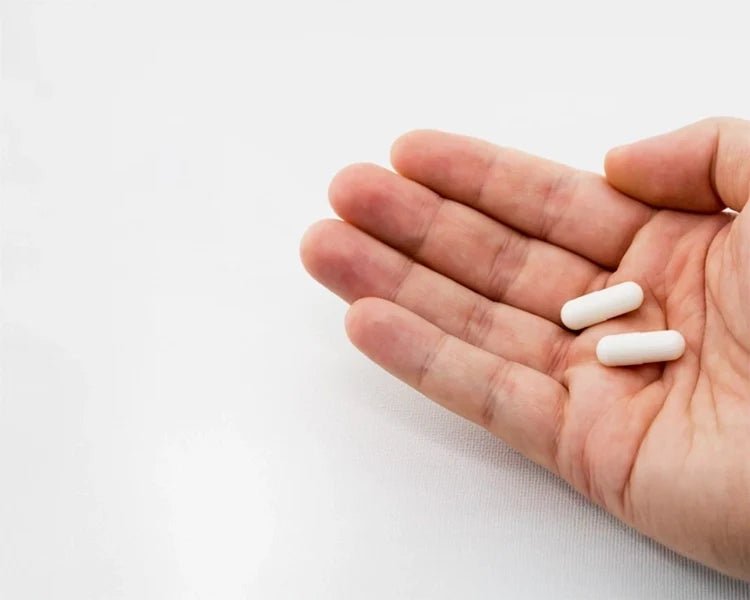Education
The most common vitamin and mineral deficiencies – how to recognize and supplement them?
Vitamins and minerals are essential for the proper functioning of the body, affecting immunity, metabolism, the nervous system and bone health. Modern lifestyles, highly processed diets, stress, and insufficient exposure to the sun can lead to their deficiencies. Symptoms are often non-specific - chronic fatigue, weakness, skin problems or difficulty concentrating can result from a lack of key micronutrients. Interestingly, research indicates that even people who care about a healthy diet can be deficient in certain nutrients, because the quality of modern food has changed significantly. The most common deficiencies and their symptoms: Vitamin D – the key to strong bones and immunity Vitamin D, known as the "sunshine vitamin", is synthesized in the skin under the influence of sunlight. Unfortunately, in our latitude during the autumn and winter months, this synthesis is almost impossible. Studies have shown that nearly 90% of Poles suffer from its deficiency, of which 60% are serious. Vitamin D deficiency can lead to muscle weakness, bone pain, low mood and increased susceptibility to infections. It is worth knowing that a deficiency of this vitamin can also manifest itself in chronic fatigue and skin problems. Interestingly, some populations, despite living in warm regions of the world, also struggle with vitamin D deficiency. This is due to wearing clothes that cover the body and using sunscreens that block the synthesis of the vitamin in the skin. A diet rich in oily fish, eggs and vitamin D-fortified milk can partially meet requirements, but most people should consider supplementation, especially in the fall and winter. Magnesium – support for the nervous system and muscles Magnesium is one of the most important minerals in the body – it takes part in over 300 enzymatic processes. Its deficiency is manifested by muscle spasms, eyelid twitching, nervousness and difficulty falling asleep. Stress and physical activity increase the demand for magnesium, which means that many people suffer from its deficiency without even realizing it. Studies indicate that nearly 70% of the population does not get enough magnesium from their diet. Interestingly, over the last 50 years, the magnesium content in vegetables and fruits has decreased by about 10%, which is mainly due to intensive farming methods and soil depletion. Magnesium can be found in cocoa, pumpkin seeds, nuts and whole grain products, but people exposed to high mental or physical stress may require additional support in the form of supplementation. Iron – essential for red blood cell production Iron deficiency is one of the most common deficiencies in the world and mainly affects women of childbearing age and people on plant-based diets. Pale skin, weakness, hair loss, headaches and fatigue may indicate an insufficient amount of this element in the body. In more advanced cases, anemia occurs, which significantly reduces the quality of life. Iron in animal products (e.g. liver, red meat) is more absorbable than that found in plants, which is why people on a vegan and vegetarian diet should pay special attention to supplementing iron. It is worth knowing that its absorption is improved by vitamin C - that is why orange juice with a meal rich in iron can increase its absorption by up to 30%. On the other hand, coffee and tea contain compounds that hinder the absorption of this mineral. Vitamin B12 – essential for the nervous and hematopoietic systems Vitamin B12 is essential for the functioning of the nervous system and the production of red blood cells. Its deficiency leads to symptoms such as numbness in the limbs, memory problems, weakness and anemia. Interestingly, vitamin B12 deficiencies can develop for years because the body stores it in the liver, but when reserves are depleted, the effects can be serious. B12 is found only in animal products, so people on a plant-based diet are particularly susceptible to deficiency. In the past, this problem was less common because people drank water from natural sources that contained bacteria that synthesized the vitamin. Today, due to water filtration and changes in agriculture, supplementation is necessary for those who do not consume meat or dairy products. Zinc - for immunity and healthy skin Zinc is a key element for the immune system, skin health, and wound healing. Its deficiency is manifested by weakened immunity, slower wound healing, skin problems, and weakened hair and nails. Interestingly, zinc also plays an important role in the functioning of the senses of taste and smell - people with zinc deficiency often complain of disorders in the perception of taste. Not everyone knows that the demand for zinc increases during periods of increased stress and during intense physical exercise. The body does not have large reserves of this element, so its regular supply in the diet is crucial. Zinc can be found in meat, fish, pumpkin seeds and nuts, but people on plant-based diets may have difficulty with its adequate supply. Vitamin and mineral deficiencies are common and can lead to many health problems. It is worth paying attention to the symptoms that the body sends and taking care of a varied diet rich in valuable nutrients. In the case of greater demand or problems with their absorption, it is worth considering appropriate supplementation. Preventive tests and a conscious approach to nutrition can help avoid more serious health consequences. Author: DOMINIKA MODRZEWSKA - dietician, acupuncturist and hirudotherapist
Learn moreImmunotherapy for Non-Hodgkin's Lymphoma - Breakthrough Treatment with NK Cells and Niacinamide
Niacinamide (Vitamin B3) Enhances NK Cell Therapy in Blood Cancers Immunotherapy in the treatment of non-Hodgkin's lymphoma and other blood cancers Oncologists have been trying for years to improve the treatment of non-Hodgkin lymphoma (NHL) and other hematological malignancies with immunotherapy. Methods used include: • Monoclonal antibodies that attack cancer cells. • Intravenous transfusion of NK (natural killer) cells, a specialized subgroup of lymphocytes capable of destroying cancer cells. Despite their great therapeutic potential, these methods have limitations, especially in advanced stages of the disease. Breakthrough: Niacinamide-Enhanced NK Cells Scientists at the University of Minnesota, working with a Jerusalem biotech company, have discovered that natural killer cells from donors can be much more effective at killing cancer cells when grown in the presence of niacinamide (the active form of vitamin B3). Why niacinamide? • Niacinamide (nicotinamide) is an absorbable form of vitamin B3 that is rapidly converted to NAD (nicotinamide adenine dinucleotide). • NAD is crucial for mitochondrial function, supporting ATP (cellular energy) production in immune system cells. • An increase in NAD levels causes increased cytotoxicity of NK cells and increased production of inflammatory cytokines, making them more effective in eliminating cancer cells. First Clinical Trial: Promising Results A clinical trial was conducted in 19 patients with relapsed or refractory non-Hodgkin's lymphoma and multiple myeloma. Patients received: • Monoclonal antibodies • NK cells cultured in the presence of niacinamide Results: • 74% of patients showed a positive response to therapy (14 out of 19 people). • 13 patients achieved complete remission. • 1 patient had a partial response to treatment. • NK cells persisted in blood, bone marrow, and tumors for up to two weeks after infusion. • The therapy was well tolerated, with no serious side effects. Broader Uses of Niacinamide: Mitochondrial and Cardiovascular Protection In addition to its use in cancer therapy, niacinamide has also shown potential to improve survival following cardiac arrest: • In animal studies, niacinamide helped restore the activity of NAD-dependent enzymes in ischemic myocardium. • This indicates that restoring NAD levels may be an effective treatment strategy for diseases associated with mitochondrial dysfunction. Niacinamide-enhanced NK therapy is a promising breakthrough in cancer immunotherapy. Although further studies are needed, preliminary results indicate that optimizing immune cell metabolism by increasing NAD levels may improve the efficacy of cancer treatment. Bibliography 1. Cichotski F. et al. Nicotinamide enhances natural killer cell function and yields remissions in patients with non-Hodgkin lymphoma. Science Translational Medicine 2023; 15(75): 705. 2. Zhu X. et al. Nicotinamide restores tissue NAD+ and improves survival in rodent models of cardiac arrest. PLoS One 2023; 18(9): e0291598. Author: Prof. Igor Bondarenko (translated from English)
Learn moreVitamin E – a powerful antioxidant. How does it work and does it protect against cancer?
Vitamin E (tocopherols) is a powerful antioxidant that protects cells from oxidative stress and supports immunity. Its regular consumption can reduce the risk of chronic diseases, including cancer. Studies show that vitamin E helps neutralize free radicals, supports the action of vitamin C, selenium and lipoic acid, and protects the body from inflammation. Check what are the best sources of vitamin E, how it affects health and why it is worth supplementing!
Learn moreHow to treat HUNGER?!
Therapeutic fasting, also known as fasting therapy, is a method used for centuries in various cultures and medical traditions. It involves the conscious and controlled restriction of food intake for a set period of time. The practice has gained new recognition due to growing evidence of its health benefits, including improved outcomes for various conditions. In 2016, Japanese scientist Yoshinori Ohsumi received the Nobel Prize for his discoveries regarding the mechanisms of autophagy, a cellular process significantly activated during fasting that plays a key role in removing damaged cells and regenerating new ones.
Learn moreTherapeutic Fasting: An Ancient Practice in the Light of New Research
Ancient Egyptian physicians noticed that people live on a quarter of the food they eat, and the rest benefits the physicians. This idea seems to be relevant today. The problem of overeating is not only a lack of self-control, but also a misinterpretation of hunger signals by our body.
Learn moreTHIS HELPS LOSE WEIGHT!
In an era of ubiquitous diets and fitness trends, many people are looking for effective methods to lose weight. However, the key to effective and healthy weight loss lies not only in exercise and diet, but also in a deeper understanding of our body and mind.
Learn moreIntermittent fasting and errors in its application.
Intermittent fasting offers many benefits, but to fully reap the benefits, you need to avoid the mistakes mentioned above. Making changes wisely, listening to your body’s signals, eating well, staying hydrated, having a healthy approach to the numbers, staying active, and being flexible in your approach are key to success. Remember, everyone is different, and the optimal approach to intermittent fasting may require individual adjustments.
Learn moreWhat does pelvic floor physiotherapy do?
Gynecological, urological and anorectal physiotherapy are specialized forms of physiotherapy that focus on the pelvic area. These therapies are designed to help people who experience pain, discomfort or dysfunction in the pelvic area. In this article, we will look at what gynecological, urological and anorectal physiotherapy is, what it involves and what benefits it can bring to patients. Gynecological Physiotherapy This type of therapy is intended to help women who experience pain, discomfort or dysfunction in the pelvic area. Gynecological physiotherapy can be used to treat a variety of conditions, including: Pelvic pain. It is a common condition that affects many women. This may be caused by various factors, including endometriosis, adhesions, scars, pelvic inflammatory disease, dysbiosis in the vulva, the effects of trauma, abuse, the consequences of treatments, radiation of the area in connection with oncological therapy, as well as dysfunction of muscles, nerves, blood vessels and lymphatics of the pelvic floor. Gynecological physiotherapy can help relieve pelvic pain by re-educating the pelvic floor muscles and improving blood and lymph flow to the area. It may manifest itself as vulvodynia - pain in the vulva, vestibulodynia - pain at the vaginal entrance, vaginism - genital-pelvic pain and penetration disorder, coxycodynia - pain in the coccyx, as well as menstrual, ovulation and other pain in the reproductive organs and pelvis. smaller. Incontinence is a condition that affects many women, especially those who have given birth or are in perimenopause and postmenopause, but is increasingly affecting young women during their reproductive years. Often associated with weakened pelvic floor muscles, but often hypertonia in this area may reveal similar symptoms. People suffering from neurological or oncological diseases also experience problems with continence. Accurate diagnostics and muscle testing are then crucial. Remember that involuntary loss of urine, gas or feces is not a physiological situation. The feeling of incomplete emptying of the bladder, pressure on the bladder, overactive bladder, weak urine stream, constipation or the feeling of incomplete evacuation are situations that should not be underestimated. Often, correcting toilet habits allows you to feel a great change. Prolapse occurs when the muscles, tendons and ligaments that support the pelvic organs weaken. Pelvic organ prolapse or prolapse is a condition in which the pelvic organs (such as the uterus, vaginal walls, bladder or rectum) fall into the vaginal canal. This may cause discomfort and pain, but also a number of other consequences. Gynecological physiotherapy can help alleviate prolapse by strengthening the pelvic floor muscles and improving support for the pelvic organs. Gynecological physiotherapy is also crucial before procedures in the case of reproductive organ static disorders, both abdominal and vaginal. In cases of organ depression in degrees I and II, the physiotherapist may select the appropriate type of pessary or special tampons to support statics and the rehabilitation process. Preparation for pregnancy, physiotherapy for pregnant women and in the early and late postpartum period. A urogynecological physiotherapist is a specialist who will help thoroughly prepare a woman's body for pregnancy and guide her until delivery . It analyzes your general health condition and, on this basis, helps you combat ailments such as sciatica . He also deals with the prevention of diastasis of the rectus abdominis muscle and the symptoms of diastasis of the pubic symphysis. A urogynecological physiotherapist also selects the appropriate activity aimed at working with the respiratory system and helps the woman prepare the muscles for exercise so that the birth is safe and without unnecessary complications. In this case, it is important to learn to relax the muscles and regulate the breathing rhythm. During the consultation, the physiotherapist carefully explains to the patient how to best prepare for childbirth, what exercises to do and what to pay special attention to. Urological Physiotherapy Urological physiotherapy is a specialized form of physiotherapy that focuses on the urinary system. This type of therapy is intended to help people who experience urinary dysfunctions such as urinary incontinence, pelvic floor pain, non-inflammatory prostate diseases, physiotherapy after prostalectomy surgery, erection problems and other sexual disorders, urinary retention. Urological physiotherapy can be used to treat a variety of conditions, including: pelvic pain with variable intensity in the lower abdomen, scrotum, testicles, perineum and thighs - CPPS, urinary incontinence, overactive bladder and urgency, erectile and potency disorders, Peyronie's disease, fertility disorders, varicocele and testicular hydrocele, difficulty urinating and residual urine. Pelvic floor problems in men have a slightly different origin than in women. Most often, they are the result of treatments for prostate, testicular or bladder cancer, non-specific inflammation of the prostate, pudendal neuralgia, spine problems, injuries, demyelinating diseases, hard faccid syndrome (pain, shortening or hardening of the penis), Peyronie's disease (disease of the connective tissue of the penis, manifested by sclerosis of the corpus cavernosum). Appropriately conducted urological physiotherapy at the pre-operative stage and then continued after the procedure significantly increases the chance of improving continence and sexual function. Urological physiotherapy aims to re-educate habits related to micturition, including toilet habits. According to scientific reports, in men with prostate problems and lower urinary tract diseases, it is advisable to adopt a sitting position during micturition in order to reduce the load on the pelvic floor and facilitate micturition. Anorectal physiotherapy Anorectal physiotherapy is a specialized form of physiotherapy that focuses on the area of the final section of the large intestine, rectum and anus. This type of therapy is intended to help people who experience pain, discomfort, or dysfunction in this area. Anorectal physiotherapy can be used to treat a variety of conditions, including: Gas and fecal incontinence. Gas and/or fecal incontinence is a condition in which a person is unable to control bowel movements and gases. This can be caused by a variety of factors, including nerve damage or muscle weakness. Constipation . Constipation is a common condition that affects many people. They may be caused by various factors, including improper diet, dehydration, muscle weakness, flatulence, pain during defecation, hemorrhoids, and painful hemorrhoids. Pelvic pain. Pelvic pain is a common condition that can affect both men and women. Anorectal physiotherapy usually involves a combination of exercises, manual therapy and toileting behavior re-education. Patients can be taught exercises to strengthen the muscles around the anus and anus. Manual therapy may include massage or stretching of the pelvic muscles. Education may include advice on posture, breathing and lifestyle changes that can help improve patients' health and quality of life. In addition to palpation skills, physiotherapists in this field have many diagnostic tools at their disposal, such as electromyography, anorectal manometry, anorectal biofeedback, EMGBiofeedback, and ultrasonography. In addition, physiotherapy includes individually selected pelvic floor muscle training, preceded by diagnostics using electromyography or ultrasound with sonofeedback and physical examination. Examination for the purposes of urological, gynecological and anorectal physiotherapy, as well as EMG diagnostics and electrostimulation are performed per rectum in men - through the rectum, in women - through the vagina (often using a vaginal speculum) and/or rectum. Similarly to women's therapy, we pay attention to correct posture, appropriate breathing pattern and pattern, and try to modify risk factors and influence habits that impair the functions of the systems. It is important to remember that working with a patient with pelvic floor problems is complex - team work - it requires close cooperation, among others: a urologist and/or oncologist, a physiotherapist, a psychologist, a sexologist, and in the case of working with patients with a history of oncology, also a psycho-oncologist. Karolina Olszewska
Learn moreSelenium
Selenium is a trace mineral in the human diet. There is also little knowledge in society about the impact of this element on human health. It is definitely not as popular as magnesium or zinc, although it is equally necessary in our diet. Humanity became aware of the existence of selenium over two centuries ago, when it was isolated by the Swedish chemist Jacob Brezelius. What more do we know about him now? First of all, it is an essential component of enzymes involved in oxidation-reduction processes and cytochrome, thanks to which it protects cell membranes, and therefore the cells themselves, against oxidative stress. Hence its beneficial effect on the immune system. People suffering from any thyroid disorder have certainly come across information about its key role in the metabolism of this gland's hormones. The problem of male infertility allowed us to draw attention to the role of selenium in proper spermatogenesis, where this ingredient is necessary for the formation of sperm with proper structure and the desired motility. Less known properties of selenium include its influence on the proper functioning of the muscular system, including the heart muscle. They are so important that in regions of the world exposed to extreme deficiencies of this element, we are dealing with a specific cardiomyopathy (Keshan disease). We will also find information confirming the impact on the low birth weight of newborns whose mothers were deficient in this microelement. There are interesting reports about the effect of selenium on the nervous system, where deficiencies manifest themselves in mood declines. And finally, related to the antioxidant effect, it influences the development/inhibition of some cancer diseases, e.g. prostate, lung or colon cancer. Selenium deficiency may manifest itself through: - hair loss and brittle nails, - nervous system disorders (low mood, depression), - fatigue, - weakness of skeletal muscles and heart muscle, - weakened immunity, - thyroid abnormalities, - male fertility disorders. Where to look for selenium? The element is taken from the soil by plants, which become food for herbivorous animals. Theoretically, both animal and plant food can be its source. Foods recommended for deficiencies are most often: offal (kidneys), eggs, dairy products, sea fish, mushrooms, garlic and Brazil nuts. The latter, generally considered to be the richest source, obviously do not come from our region, and when buying them we may not be 100% sure whether they actually come from areas rich in this element. In practice, in Polish latitude, we deal with low selenium content in the soil, which results from the geographical location. The rocks from which the soil is formed in our native areas are very low in selenium. Additionally, the acidic nature of these soils makes it difficult for plants to absorb the said mineral. Supplementation may be the solution to replenish the deficiencies. The preparations available on the market include both organic forms (l-selenomethionine) and inorganic forms, e.g. sodium selenate. The daily recommended intake of selenium for adults is 55 mcg. However, supplements may contain a dose almost four times higher, up to 200 mcg. When supplementing selenium, it is worth remembering that it is a trace element for humans, which means that there is a small difference between a therapeutic and toxic dose. Therefore, despite potential deficiencies, when deciding on supplementation, it should be used very carefully, in accordance with the dictum of Paracelsus Everything is poison and nothing is poison. Only the dose makes a substance not a poison. Marta Wcześniak BIBLIOGRAPHY: Piotrowska "Content of selenium in cultivated soils of Poland", Roczniki Gleboznaczne T XXXX, No. 1, Warsaw 1984 Golonko, B. Matejczyk "Two faces of selenium, selected aspects of the biological activity of selenium" Civil and Environmental Engineering 9 (2018) Ratajczak, M. Gietka-Czemel "The role of Selenium in the human body" Advances in Medical Sciences 2016 XXXIX(12) Resolution No. 7/2021 of the Team for Dietary Supplements of 28/10/2021
Learn more
